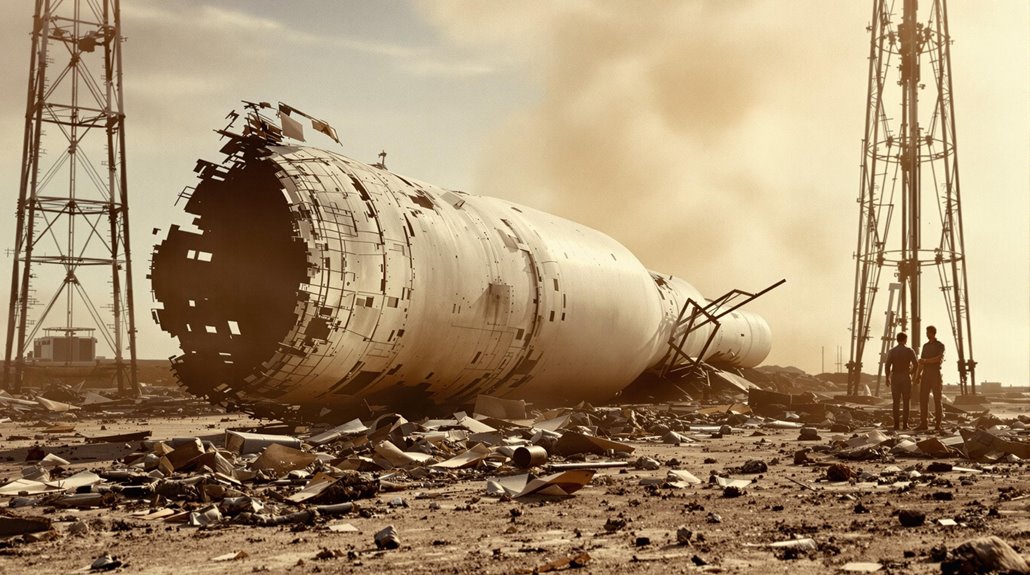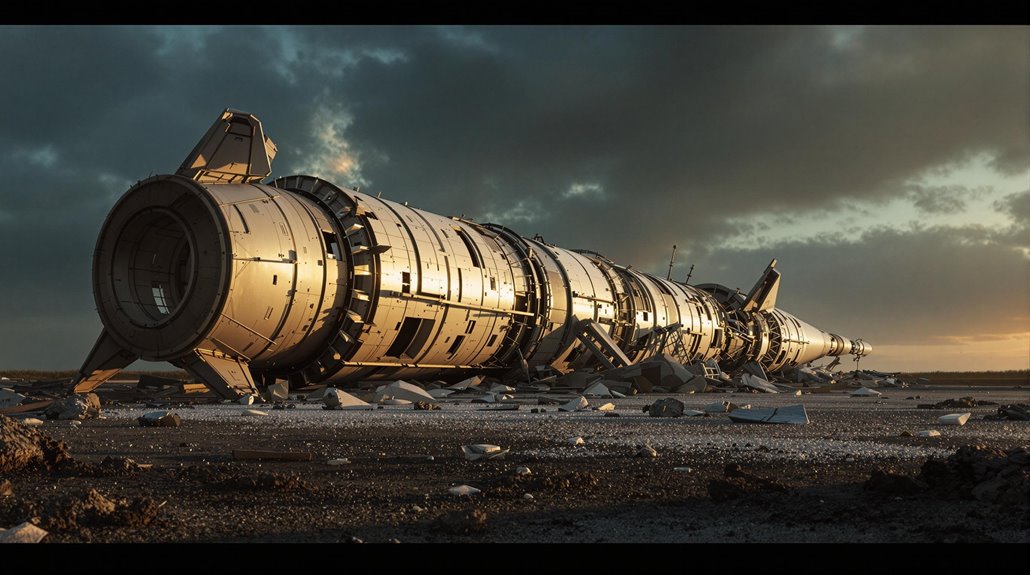Kaputnik: America’s Hilariously Bad Rocket Failure
While the Soviet Union was celebrating its Sputnik success, you wouldn't have wanted to be anywhere near America's answer to the space race in December 1956. The Vanguard rocket, mockingly dubbed "Kaputnik," managed to soar a mere four feet before crashing and exploding in a spectacular fireball. What should've been America's proud moment in the spotlight turned into an international punchline—but there's more to this embarrassing Cold War mishap than meets the eye.
The Cold War Space Race Heats Up

While Americans enjoyed post-war prosperity in the 1950s, the Soviet Union delivered a shocking blow to U.S. confidence by launching Sputnik 1, the world's first artificial satellite.
You might've heard the beeping signals that captivated millions as it orbited Earth for 21 days. The Soviets didn't stop there – they quickly followed with Sputnik 2, carrying the dog Laika, and then Sputnik 3, a massive 3,000-pound spacecraft.
The Cold War rivalry reached new heights as space exploration became the ultimate proving ground. The Space Race would ultimately culminate in the first Moon landing by America. The U.S. faced numerous rocket failures with the Vanguard program before achieving success.
You'd think the U.S. would've been prepared, but it took until January 1958 to launch Explorer 1. This prompted the creation of NASA and sparked an intense competition that would define the era, with both nations pouring billions into their space programs to demonstrate technological superiority.
The Grand Promise of Project Vanguard
In response to the Soviet space achievements, the United States pinned its hopes on Project Vanguard – an ambitious program to launch America's first satellite into orbit.
You'd think the choice was obvious: use proven military rockets. Instead, President Eisenhower opted for a civilian-led initiative that wouldn't interfere with military missile development.
The program promised major scientific innovation through its three-stage rocket design, specifically created for satellite launches. Based on the successful Viking rocket technology, Vanguard aimed to showcase America's technological advancements while emphasizing research over military applications. The initiative paralleled modern programs like Project Vanguard today, which focuses on increasing private capital for defense technology development. With a commitment like the Freed Center project, the program demonstrated ambitious goals for technological advancement.
Under the Naval Research Laboratory's management, the project marked the first non-military program at Cape Canaveral. Despite initial challenges, Vanguard's expertise would later prove invaluable, contributing to NASA's formation and laying the groundwork for modern satellite communications.
Four Feet of Glory: The Launch Day Disaster
On December 6, 1957, millions of Americans gathered around their television sets to witness what should have been a triumphant moment in U.S. space history.
Instead, you would've seen the Vanguard rocket rise just four feet off the launch pad before losing thrust and crashing back down in a spectacular explosive failure.
The rocket's fuel tanks ruptured on impact, creating a massive fireball that destroyed the vehicle and severely damaged the pad.
The failure occurred due to inadequate fuel pressure in the first stage engine system.
In a bizarre twist, the tiny 3.3-pound satellite survived, landing in nearby bushes while still transmitting signals.
The Naval Research Laboratory had managed the ambitious program from its inception.
The humiliating display prompted Soviet delegates to mockingly offer aid to "undeveloped countries," while the press had a field day with nicknames like "Flopnik" and "Kaputnik."
The disaster even forced the New York Stock Exchange to temporarily suspend trading of Martin Company stock.
Why The Rocket Failed
The spectacular failure of Vanguard had a complex web of technical problems at its core.
At the heart of the disaster was a fuel system breakdown that started with low tank pressure during ignition. This led to a dangerous fuel leakage and injector malfunction, allowing hot combustion gases to back up into vital components.
You'd think GE's technicians would have caught these issues during testing, but they missed essential warning signs. The failed launch was broadcast on live television for all Americans to witness.
While they attempted a quick fix by increasing tank pressure and later adding ethane gas to boost fuel force, it was too late for this launch.
The combustion chamber ruptured just one second after liftoff, creating a devastating shock wave that destroyed the rocket's structural integrity.
Limited telemetry data made it challenging for engineers to determine the exact failure sequence with complete certainty.
The embarrassing failure led critics to mockingly nickname the mission Flopnik and Kaputnik in the press.
The Media's Merciless Response

The public outrage was palpable.
Senator Lyndon B. Johnson described it as the most humiliating moment for the United States.
Even the BBC joined the mockery by airing a calypso singer's taunting performance.
The New York Times declared it a "Blow to US Prestige," while the international press gleefully reported America's humiliation.
The failure hit so hard that trading of Martin Company stock was suspended on the NYSE, and one Washington office worker broke down in tears at the news.
 Vanguard TV-3 rocket exploded just seconds after liftoff, reaching only 1.2 meters before crashing back to the launch pad.
Vanguard TV-3 rocket exploded just seconds after liftoff, reaching only 1.2 meters before crashing back to the launch pad.
The Silver Lining: Lessons and Legacy
Despite the media's brutal response and public embarrassment, Vanguard's spectacular failure sparked innovations that shaped America's future in space. The "build, test, fly" approach taught invaluable innovation lessons about embracing failure as part of progress, rather than over-engineering everything to perfection.
You can see Vanguard's lasting impact in several ways. Its upper stage design influenced future rockets, while Vanguard 1 became the first solar-powered satellite and remains the oldest human-made object in orbit.
The program's failure resilience led to NASA's creation in 1958, centralizing America's civilian space efforts under one efficient agency. Most importantly, it revolutionized testing procedures and safety protocols, contributing to the Apollo program's perfect launch record. This philosophy of learning from failures continues today, as demonstrated by SpaceX's Starship explosion providing valuable flight data for future improvements.
Sometimes, you need to fail spectacularly to succeed magnificently.










